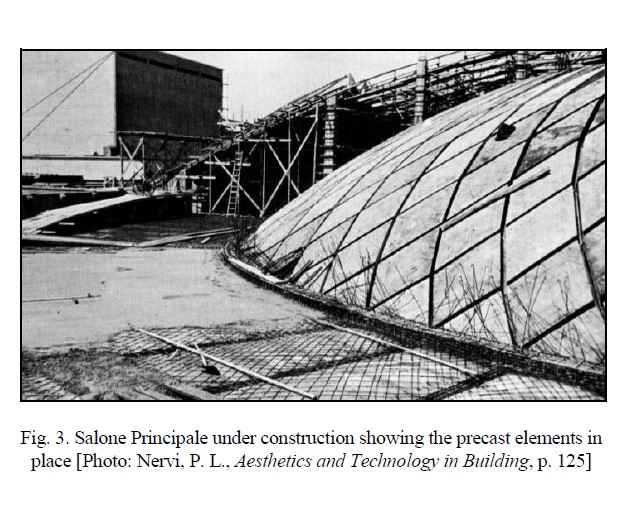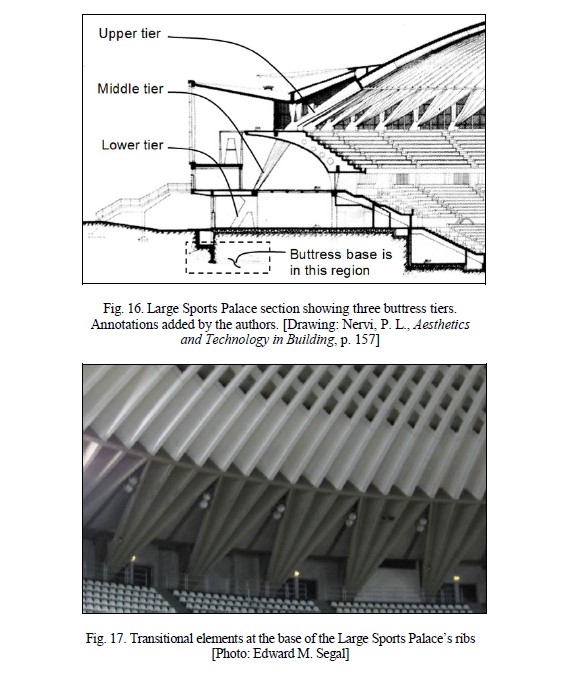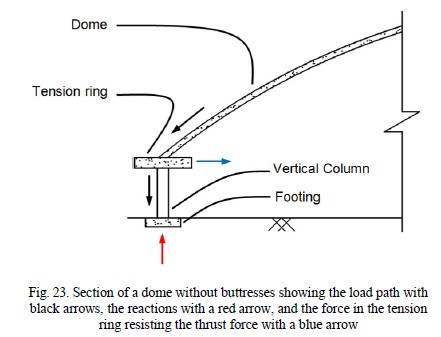To commemorate Prof. David Billington, I feature a series of posts about the works of Pier Luigi Nervi. In the previous I wrote about the Thompson Area and the Leverone Field House projects in Hanover, USA. In this post I write about his work in USA where he did not have total control over the construction process. This post is based on a paper I co-authored with Prof. Ted Segal (see details at the bottom of this post). The other posts will focus on his initial and most mature work in Italy (i.e. ribbed floors and his spectular work for the 1960’s Olympic Games), and finally about his unrealized designs for the world (i.e. design for the Swindon and Kuwait stadia).
Today, despite the international decline in the construction of thin concrete shell roofs that began in the 1960s [1], the dome is one reinforced concrete shell type that is still being constructed in great numbers in the United States of America (US). Engineers have continued to build domes because air-supported formwork makes construction of this shell type economical [2]. While dimensions vary, there is little play in these forms; domes have smooth interiors and exteriors and the thrust forces at their bases are resisted by belowground or elevated ring beams. These shells are economical, but are not as visually interesting as some of the domes that preceded them. The Norfolk Scope Arena (Fig. 1) is an example of a US dome whose form contrasts sharply with the domes built using air-supported formwork. Studio Nervi consulted on the project and the structure features Pier Luigi Nervi’s characteristic interior ribs and buttresses (inclined columns). The structure’s design was completed collaboratively with Williams and Tazewell & Associates (architects) and Fraioli-Blum- Yesseleman (structural consultants). This paper does not attempt to clarify the role that Studio Nervi and Pier Luigi Nervi specifically played in the design and construction of Scope Arena. Whatever Nervi’s involvement, it is clear that the form of Scope Arena is reminiscent of his earlier domes such as the Little and Large Sports Palaces.

The first objective is to show the progression in Nervi’s dome designs. We identify chronologically when interior ribs and buttresses, prominent elements at Scope Arena, initially appear in Nervi’s domes. The second objective is to demonstrate the various ways Nervi details these elements in his domes. After showing this diversity broadly across eight of his works, the paper describes specifically how the interior ribs and buttresses are configured at Scope Arena and then compares this arrangement to those of the visually different Little and Large Sports Palaces. The third objective is to show that Scope Arena’s ribs and buttresses give the shell a unique form among other US domes from the same era: the University of Illinois, Assembly Hall (Champaign, US, 1963), the University of Virginia, University Hall (Charlottesville, US, 1965), and the Kingdome (Seattle, US, 1976 and demolished in 2000). These comparisons seek to place Nervi’s Scope Arena in the context of its contemporaries so that its contributions to the field of thin concrete shell roofs can be better understood.
Interior Ribs in Nervi’s Domes
The 40 m half-dome at the Exhibition Hall, Salone Principale (Turin, Italy, 1949) is Nervi’s first dome at a significant scale that featured interior ribs (Fig. 2). To construct the half-dome (Fig. 3), Nervicombined precast and cast-in-place elements in a way that he had only previously attempted on “. . . works of minor importance” [3, p. 69]. For the Salone Principale Nervi used precast diamond-shaped panels as forms (supported on scaffolding) for the cast-in-place concrete that once cured acted compositely with the panels to form a shell with interior ribs. Nervi’s decision to use precast ribs followed from his earlier difficulties with a cast-in-place monolithic dome for the church of San Marcellino in Genoa [4] and the shortage of timber in Italy that necessitated minimizing formwork [5]. At that time, Nervi had experience with combining precast and cast-in-place elements for his barrel vaults (e.g. airplane hangars for the Italian Air Force, Orbetello, Orvieto, and Torre del Lago, Italy, 1939-1941 [6], [7]) and he realized that combining these elements (albeit in a different way) for a dome would offer construction benefits. He developed this specific construction procedure while his office was closed in 1944 during World War II [4].

 When reflecting on Salone Principale Nervi stated: “The process proved to be very effective from a technical and economic point of view and resulted in great plastic richness” [4, p. 103]. This half-dome showed the potential of the construction method and the resulting elegance at a large-scale. Nervi’s major long span domes that follow all feature interior ribs formed from these diamond panels, similar triangular panels, or precast corrugated elements with transverse stiffeners (Fig. 4). To build a corrugated dome, the precast elements were arranged on scaffolding, concrete was cast in the valleys of the corrugations, precast slabs closed the elements at their tops, and concrete was cast along joints between adjacent elements to create continuity [4]. The timeline in Fig. 5 shows by minimum span the type of precast elements used in the domes listed in Table 1. Note that the minimum span for Salone Principale is taken as half the diameter, 20 m. Aside from Scope Arena which has triangular panels, the corrugated elements were used or (planned to be used) for spans greater than 60 m while diamond panels were used for spans less than 60 m.
When reflecting on Salone Principale Nervi stated: “The process proved to be very effective from a technical and economic point of view and resulted in great plastic richness” [4, p. 103]. This half-dome showed the potential of the construction method and the resulting elegance at a large-scale. Nervi’s major long span domes that follow all feature interior ribs formed from these diamond panels, similar triangular panels, or precast corrugated elements with transverse stiffeners (Fig. 4). To build a corrugated dome, the precast elements were arranged on scaffolding, concrete was cast in the valleys of the corrugations, precast slabs closed the elements at their tops, and concrete was cast along joints between adjacent elements to create continuity [4]. The timeline in Fig. 5 shows by minimum span the type of precast elements used in the domes listed in Table 1. Note that the minimum span for Salone Principale is taken as half the diameter, 20 m. Aside from Scope Arena which has triangular panels, the corrugated elements were used or (planned to be used) for spans greater than 60 m while diamond panels were used for spans less than 60 m.



Buttresses in Nervi’s domes
Unlike interior ribs, buttresses do not appear in all of Nervi’s major domes; they are not present in two early works, the Salone Principale and Festival Hall (Chianciano Terme, Italy, 1952). Nervi’s original sketches for Salone Principale indicate that he was considering using a combination of buttresses and vertical columns to support the dome (Fig. 6). By then Nervi had experience using buttresses to support many of his barrel vaults including the one over the main area of the Salone Principale, so it is not surprising that he considered using them to support his domes. However, in the final structure the buttresses were omitted. At the dome’s base the thrust forces are carried into a slab and then into what Nervi refers to as “. . . special reinforced concrete structures which remained hidden in the wall which divides the main hall from the semicircular area” [4, p.102]. While Nervi developed a feasible solution to accommodate the shell’s asymmetry, he uncharacteristically concealed the structural system. The buttresses would have clearly indicated how the thrust forces are carried to the ground and additionally would have provided visual continuity at the transition between the dome and adjacent barrel [7]. Nervi’s next dome, Salone C (Turin, Italy, 1950), was his first to use buttresses, a set of inclined arches (Fig. 7).

The timeline in Fig. 10 shows which Nervi domes have buttresses (see Figs. 8 and 9 for load paths for domes with and without buttresses). For those domes with buttresses the timeline makes three additional distinctions: i) one tier vs. multiple tiers, ii) simple vs. complex cross sections, and iii) edge beams vs. transitional elements. One tier vs. multiple tiers indicates whether there are one or more buttress levels in elevation. Simple vs. complex cross-section refers to how much bidirectional cross-section variation the buttresses have along their lengths. Simple means little variation while complex means significant variation. Edge beams vs. transitional elements differentiates between the types of members at the interface between ribs and buttresses. Edge beams are continuous members that act like transfer girders at the dome’s base whereas transitional elements are discrete components that channel loads from multiple ribs to a single buttress.

 The timeline in Fig. 10 demonstrates that Nervi not only consistently included buttresses in his work beginning in 1953, but also varied the configurations of these elements.
The timeline in Fig. 10 demonstrates that Nervi not only consistently included buttresses in his work beginning in 1953, but also varied the configurations of these elements.

Scope Arena’s Form
Scope Arena is a multi-purpose stadium that is circular in plan. Covering the stadium is a dome with a clear span of 99.5 m. The base and crown of the dome are 12.6 m and 29.7 m above the ground, respectively. Loads from the dome are carried compositely by the shell (14.3 cm thick, minimum) and stiffening ribs (variable depth and width) to a cast in-
place edge ring beam (approximately 4.5 m deep by variable width) that is supported by a set of cast-in-place buttresses. An edge beam is required because the dome’s buttresses do not align with the ribs. The buttresses then transfer the loads to a below-ground cast-in-place posttensioned ring (0.91 m deep by 6.43 m wide). Table 2 summarizes the dimensions for the dome, interior ribs, edge ring beam, buttresses, and post-tensioned ring [8].
 Scope Arena’s Interior Ribs
Scope Arena’s Interior Ribs
Early design drawings show the dome constructed with precast diamond-shaped elements [9]. However, in the final shell precast triangular-shaped elements were used (Figure 11). In plan the precast elements create a set of hoop ribs and a set of ribs that radiate from the center of the dome (Figure 12). The direction of the dome’s hoop and
meridian stresses align with the hoop ribs and the angle bisector of the radiating ribs, respectively. The ribs vary in depth from 36.4 cm to 55.8 cm and in width from 11.4 cm to 33.8 cm [8].


Scope Arena’s Buttresses
There are forty-eight buttresses with complex cross-sections arranged in pairs to form twenty-four V-shaped elements. The bottom of each V frames into a base element that transfers the loads from the buttresses to a below-ground post-tensioned ring. These base elements increase in dimension at the ground to almost the full width of the tension ring (Fig. 13).

A comparative analysis of Scope Arena and the Little and Large Sport Palaces
Among Nervi’s domes, Scope Arena is most similar to the Little and Large Sports Palaces; however, all three feature different configurations of interior ribs and buttresses. Table 3 expands on Table 1 and Fig. 10 to provide additional information on these elements in the three domes.

Interior Rib Comparisons – Nervi’s Domes
Scope Arena’s span, 99.5 m, is approximately the same as the Large Sports Palace’s span, 100 m. However, Nervi opted to use precast triangular-shaped panels closer in form to the diamond-shaped panels at the Little Sports Palace (Fig. 14), than to the corrugated elements at the Large Sports Palace (Fig. 15). The triangles produce hoop ribs that interrupt the continuity of the ribs radiating from the center. This rib network is visually dense; more of the shell body would have been visible if triangular elements were combined into diamonds as shown in early design drawings.

 Buttress Comparisons – Nervi’s Domes
Buttress Comparisons – Nervi’s Domes
The overall buttress arrangement at Scope Arena, a single tier of twenty-four pairs of V-shaped (in plan) buttresses is similar to the Little Sports Palace’s arrangement of thirty-six Y-shaped (in plan) buttresses. In contrast, the Large Sports Palace has three tiers of buttresses to transfer the reactions from the dome to the ground (Fig. 16). The upper tier is essentially a set of transitional elements that direct the loads from the dome’s ribs to the linear (in plan) middle tier buttresses (Fig. 17).
 The Large Sports Palace’s transitional elements are similar to those used in the Little Sports Palace except there are no openings between elements in the latter (Fig. 18). Transitional elements clearly articulate the load path and provide visual continuity between interior ribs and buttresses that do not align. Scope Arena lacks these transitional elements and instead features an inexpressive ring edge beam that is
The Large Sports Palace’s transitional elements are similar to those used in the Little Sports Palace except there are no openings between elements in the latter (Fig. 18). Transitional elements clearly articulate the load path and provide visual continuity between interior ribs and buttresses that do not align. Scope Arena lacks these transitional elements and instead features an inexpressive ring edge beam that is
made worse by a precast gutter on the exterior. While at the Little Sports Palace the true thickness of the shell is visible from the exterior, at Scope Arena the edge elements obscure the shell’s lightness and disrupt the visual tie between the dome’s interior and exterior.
 The detailing of Scope Arena’s buttresses is closest to the detailing of the Large Sports Palace’s middle tier of buttresses. These elements have complex cross-sections that vary in two dimensions. At Scope Arena this shaping is extended to the buttress bases. Visually, these bases are more prominent than those at the Roman domes and also express the tension ring required to resist the dome’s thrust forces. In contrast, where the Little Sports Palace’s buttresses meet the ground, the base is only slightly larger than the buttress. The tension ring is not directly below the ground and the buttress continues into the ground and then flares out into a larger base where it meets the tension ring
The detailing of Scope Arena’s buttresses is closest to the detailing of the Large Sports Palace’s middle tier of buttresses. These elements have complex cross-sections that vary in two dimensions. At Scope Arena this shaping is extended to the buttress bases. Visually, these bases are more prominent than those at the Roman domes and also express the tension ring required to resist the dome’s thrust forces. In contrast, where the Little Sports Palace’s buttresses meet the ground, the base is only slightly larger than the buttress. The tension ring is not directly below the ground and the buttress continues into the ground and then flares out into a larger base where it meets the tension ring
(Fig. 19) [10]. There is no expression of the size of the tension ring above ground.
The Large Sports Palace falls between Scope Arena and the Little Sports Palace in terms of expression at its buttresses’ bases. For the Large Sports Palace’s upper buttress tier, the bases are visible, but do not have to be significant in size because the loads are being transferred to the middle tier of buttresses. For the middle tier the bases again do not have to be that large. The change in cross-section occurs below the slab, at the top of the lower tier buttresses; there is no visual expression of the cross-section increase above the slab. Finally, the lower tier buttresses have significant bases, but they occur below ground (Fig. 16) [4].

A comparative analysis of Scope Arena and other US domes
Scope Arena’s form shares some features with other long span, circular in plan US domes, but these similarities are not as evident as those between Nervi’s domes. Table 4 summarizes key dimensions and design details for these domes.
Rib Comparisons – US Domes
All four US domes have stiffening ribs, but their configurations vary and produce different visual results. Assembly Hall (Fig. 20) is constructed from cast-in-place folded-plates with ribs stiffening the valleys and peaks [11]. The corrugations and ribs are visible from both the interior and the exterior with a visual effect that is closer to that of
the Large Sports Palace than that of Scope Arena. Both the Kingdome (Fig. 21) and University Hall (Fig. 22) have radial arch ribs. At the former the ribs are on the exterior, while at the latter the ribs are on the interior and supplemented with transverse stiffening ribs. As a result of the ribs’ location and the dome’s scalloped geometry, the Kingdome’s exterior resembles University Hall’s interior. While University Hall’s
two-way series of interior ribs are the closest visually to those at Scope Arena, they also articulate a different load path. At University Hall the dome is a set of curved shell panels supported on a system of arches and stiffened by transverse ribs. The arches transfer the dome’s loads to its base [12]. In contrast, at Scope Arena the ribs and shell work compositely to support the dome’s loads.


 Buttress Comparisons – US Domes
Buttress Comparisons – US Domes
Unlike Scope Arena where its tension ring is below ground, the other three shells have their tension rings elevated above the ground at the dome bases (Fig. 23) [11], [12], [13]. With the thrust forces carried by the elevated tension rings, only vertical forces are transferred to the ground. Vertical forces are carried by vertical columns at University
Hall and the Kingdome and by buttresses at Assembly Hall. Assembly Hall’s buttresses lean away from the dome’s center in contrast to those at Scope Arena that follow the angle of the dome’s resulting forces.
Structurally, it is inefficient to transfer only vertical forces through inclined elements. Assembly Hall’s buttresses support loads from elements other than the dome that may justify their use instead of vertical columns or perhaps the buttresses are provided for functional and/or aesthetic reasons. Visually these buttresses close off the base whereas at Scope Arena the base is open and looks lighter.

Conclusions
Scope Arena was constructed late in Nervi’s career and prominently features interior ribs and buttresses in a new configuration. By that time, these were Nervi’s characteristic elements; he had already combined them at previous domes in various ways. This text began by identifying Salone Principale and Salone C as the first Nervi domes to feature interior ribs and buttresses, respectively. Next, we showed
the variety in which Nervi configured these elements in his domes, first, broadly across eight of his works and then, specifically through comparisons between Scope Arena and the Little and Large Sports Palaces. The most distinctive features of Scope Arena are the buttresses and the buttress bases with their complex cross-sections. The buttress bases are especially significant because they express the below-ground tension ring required to resist the dome’s thrust forces. Finally, we compared Scope Arena to other US domes from the same era and showed that Nervi’s characteristic elements are not characteristic to other US domes. Scope Arena is a one-of-a-kind US dome that is a symbol of the time that it was built. Due to the difficulty of constructing new concrete domes at the same scale and variation shown here, it is important to preserve and maintain significant,
existing shells, so that physical artifacts of this construction era remain. Scope Arena is a prime example.
References
[1] Billington D. P. and Segal E. M., The Decade 1960-1969: The First Ten Years of the IASS, In: Mungan I. and Abel J. F. (eds) Fifty Years of Progress for Shell and Spatial Structures; In Celebration of the 50th Anniversary Jubilee of the IASS (1959- 2009), International Association for Shell and Spatial Structures (2011).
[2] South D. B., Economics and the Thin Shell Dome, Concrete International, Vol. 12, No. 8 (1990) pp. 18-20.
[3] Nervi P. L., Structures, McGraw-Hill Book Company, Inc. (1956), Trans. Salvadori G. and Salvadori M.
[4] Nervi P. L., Aesthetics and Technology in Building, Harvard University Press (1965), Trans. Einaudi R.
[5] Nervi P. L., Concrete and Structural Form, The Structural Engineer, Vol. 36, No. 5 (1956) pp. 155-169.
[6] Nervi P. L., Precast Concrete Offers New Possibilities for Design of Shell Structures, Journal of the American Concrete Institute, Vol. 24, No. 6 (1953) pp. 537-548.
[7] Nervi P. L., The Works of Pier Luigi Nervi, Frederick A. Praeger, Inc., Publishers (1957), Trans. Priefert E., Figure captions, Joedicke J.
[8] Final Norfolk Scope Arena design drawings, 1968, located in Norfolk, VA, Department of Public Works.
[9] Early Norfolk Scope Arena design drawings, located in Rome, MAXXI, Archivio Pier Luigi Nervi.
[10] The Little Sports Palace design drawings, 1956-1957, located in Parme, CSAC, Archivio Pier Luigi Nervi.
[11] A New Machine Prestresses a Folded-Plate Concrete Dome, Engineering News-Record, Vol. 168, No. 21 (1962) pp. 44-46.
[12] Berger H., Scalloped Prestressed Dome from Prestressed Elements, Journal of the American Concrete Institute, Vol. 63, No. 3 (1966) pp. 313-323.
[13] Christiansen J. V., The Kingdome, ASCE Fall Convention and Exhibit, San Francisco, Preprint 2946 (1977) pp. 1-26.
This post is based on the following paper:
E. Segal and S. Adriaenssens, ‘Norfolk Scope Arena: A US Dome with a Unique Configuration of Interior Ribs and Buttresses’ Journal of International Association of Shell and Spatial Structures, vol. 54, pp. 189-198, 2013.

